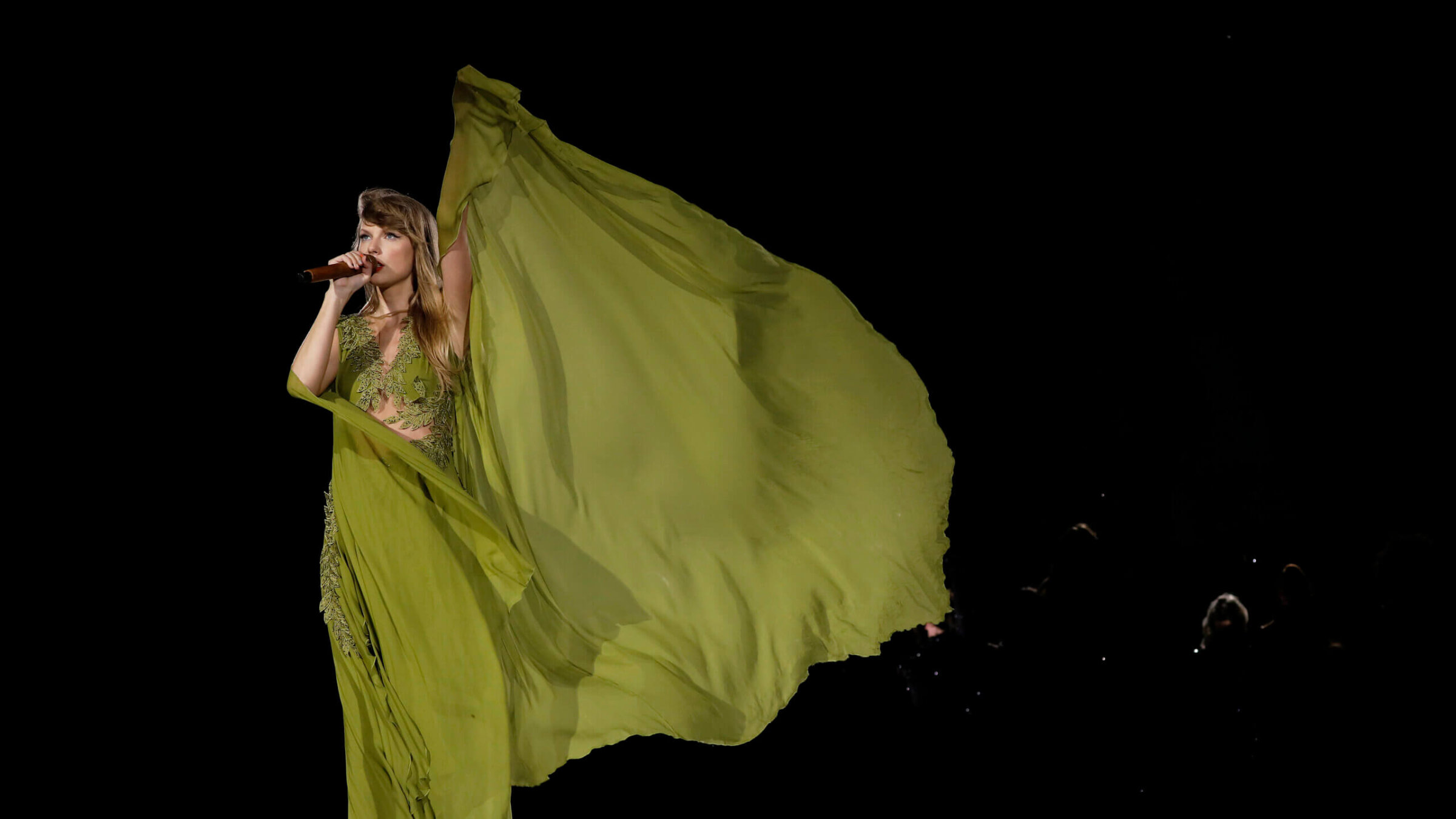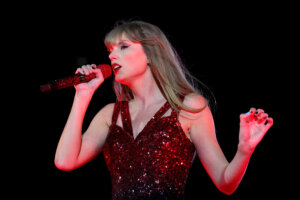Is this a vision of heaven or is it a Taylor Swift concert?
For one fan, his parents and 80,000 others, a blissful revelation — from one era to the next

Taylor Swift in concert in Chicago, 2023.
We were told get there early. We were told there would be traffic — especially on the first night — and that the lines for merch and just to enter the stadium stretched for blocks. We were told there would be 80,000 people there. Park near an exit, we were told. We were stressed out. I had not been to a stadium show since the Grateful Dead in Albany in 1990 and that was not even one-sixth of this size.
My son, Julian, who is 10, is obsessed with Taylor Swift. At the peak of the pandemic, in July of 2020, when Folklore was released, we listened to it together, the songs soothing to me, redolent of my youth spent swaying to the Indigo Girls and Edie Brickell. It sounded nostalgic, the tinge most everything wears since 2020.
I was driving the highways of Eastern Pennsylvania with Julian, then 7, who sat in his car seat in the back. Why we were driving I can’t say as I don’t remember going anywhere then, but the song “Betty” came on.
But if I just showed up at your party
Would you have me?
Would you want me?
Would you tell me to go f— myself?
Or lead me to the garden?
In the garden would you trust me
If I told you it was just a summer thing?
I’m only 17, I don’t know anything
But I know I miss you
Two years earlier, we had moved to Pennsylvania from Brooklyn, where my spouse and I had lived for over 20 years, and here we were, no BQE traffic, no jammed-up Smith Street, or Atlantic Avenue crush, just an empty highway, moving toward a large, unremarkable horizon. Everything TS was singing about was far behind me now. When I looked in the rearview I saw Julian listening intently, as if entering the lyrics, wondering at their intensity: What kind of party is this? Is there cake? What is 17? What will happen in the garden? From that moment on, I was mostly looking back. But of course Julian was only at the beginning.
We pull into the parking lot as Julian finishes making his friendship bracelets in the backseat, slipping over 30 beaded bracelets onto his slim wrist, those with the names of albums, snippets of lyrics, and those emblazoned with Taylor’s name — I had read that fans on the tour were trading bracelets.

We park near the exit, just as we were told. Outside the stadium, teenage girls stand beneath the blazing sun in cowboy boots and gauzy flower dresses and leotards, TS embroidered into their jackets and jeans, capes emblazoned with album covers, heart sunglasses covering their freckled faces. Some make bracelets and drink White Claw. Several young women run up to Julian to trade bracelets, but he doesn’t want to give any of his away. They slip theirs on him anyway, laughing as they run away together, giggling and holding hands.
After a long yet easy wait, we enter the stadium, and are each handed another bracelet, this one with a ribbon stating the corporate sponsor’s logo, where a little plastic box is looped on at the center. We are told this will light up when Taylor hits the stage. Our seats, on the second tier, are front and center. I had bought our tickets on the day they sold on Ticketmaster, blissfully unaware, once I had obtained a password from my generous college roommate who I had in fact seen the Dead with 33 years earlier, that there were any technical issues.
As seats steadily fill we all watch young girls, each dressed in a different Taylor era, pose for selfies against the backdrop of the enormous screen playing outtakes of a Swift music video. Here, then here, then here: they position themselves for their streams and feeds and stories and grids, faces changing as if they’re performing an act of mime.
Gayle (whose hit “abcdefu,” launched her) is the first opener, and I cry when she thanks the song she wrote that made all her dreams come true. After Phoebe Bridgers, whom I would have come to see on her own, plays a kickass set, a clock goes up on the screen. Everyone — everyone — screams. The clock ticks down toward midnight, which of course resonates with Swift’s latest album, Midnights.
One minute … and here we are: Beneath massive flowering labial fans, Taylor Swift enters in her sparkly silvery Lover-era leotard, and begins singing “Miss Americana & the Heartbreak Prince.”
The crowd goes insane. The bleachers begin to sway — they sway! — and I try without success not to catastrophize. She appears as a pinprick on an endless stage that takes up nearly half the field, and also as an Amazon princess on a massive high-definition screen.

The night is magic. The stage has a trap door she can disappear in and out of. Taylor plays for three hours and 45 minutes with a live band tucked off to the side and incredible back up dancers — I was obsessed with this one who had amazing style and charisma. Each performance takes us into an era through costume, dance, secret codes and world building.
The sets at the back are often houses, each room a space representing a snippet of time. Repping the Lover era is a jewel house that looks as if it’s made of Magna-tiles, which turns into a corporate office with steel rails and bridges she dances through as she sings “The Man.” Evermore is a cave of trees fronted by a moss-covered piano, and Folklore is a remote forest A-frame. As I watch the girls weeping and singing and laughing and screaming around us I can’t shake the tender metaphor that we are all rooms of a house. How will any of us ever be all the rooms, all our eras, all at once?
Taylor seems utterly invincible, never breathless, though we are as she dives into the stage, which turns into a screen; she seems to swim out to us for “Lavender Haze” from Midnights. Torches blaze; flames alight during “Bad Blood” from 1989. There are Fosse moves and top hats (Red) and a massive digital snake (Reputation) and a world premiere of “Karma” (Midnights) with Ice Spice, who later joins her on stage, and there is also just Taylor in her white flowing Ferretti dress, her swirling sprinkling of imaginary fairy dust, reminiscent of Stevie Nicks (Folklore). The sequins in the crowd catch the light like old-fashioned camera flashes. Our bracelets flash white or blue or red, creating a mesmerizing, collectivizing crowd show that makes a massive stadium of concertgoers somehow intimate.
For one of the surprise songs Swift has been playing acoustically each night, Jack Antonoff, her longtime collaborator and local Jersey Yeshiva boy, appears from below, to sing “Getaway Car” from Reputation. It’s the only other time I get misty — 80,000 are stomping and cheering wildly for an outspoken righteous Jew who I’m sure has a Star of David slung cold against his skin beneath his perfectly broken-in leather jacket. Other than this dizzying sway of the ground beneath our feet, it’s relatively stress-free, which I realize might just be because there are so few men here to push and fight and get drunk and ruin everything.
If I had come dressed as an era it would of course have been Folklore. This is my PA era, standing in a long cape and braids, alone in the woods in the gloaming. Tonight, I run my fingers along the beaded friendship bracelet Julian gave me. I feel like I will never take it off. After we get home, the stadium bracelets flash in the entryway for three days, until, my husband notes, Taylor has left town.





















